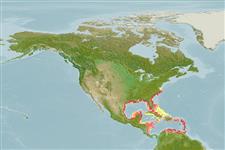>
Eupercaria/misc (Various families in series Eupercaria) >
Sciaenidae (Drums or croakers)
Etymology: Cynoscion: Greek, kyon = dog + Greek, odous = teeth + Greek, skion, skiaina = barbel, red mullet (Ref. 45335).
Environment: milieu / climate zone / rango de profundidad / distribution range
Ecología
marino; salobre demersal; rango de profundidad 2 - 18 m (Ref. 1183). Subtropical; 39°N - 9°N, 98°W - 59°W
Western Atlantic: Maryland to northeastern Florida in the USA and throughout Gulf of Mexico. Reported from Campeche Bank in Mexico (Ref. 5733). Often misidentified as Cynoscion regalis (Ref. 3702).
Length at first maturity / Tamaño / Peso / Age
Madurez: Lm 15.8, range 14 - 17 cm
Max length : 36.0 cm TL macho / no sexado; (Ref. 3702); common length : 25.0 cm TL macho / no sexado; (Ref. 3702); edad máxima reportada: 1.20 años (Ref. 31629)
Espinas dorsales (total) : 11; Radios blandos dorsales (total) : 26 - 31; Espinas anales: 2; Radios blandos anales: 8 - 11; Vértebra: 27. Colour greyish above and changing abruptly to silvery below. Back and upper sides sometimes with very faint irregular rows of spots. Dorsal fin dusky, other fins pale to yellowish. Mouth large, oblique, lower jaw projecting. Upper jaw with a pair of large canine-like teeth at tip. Lower jaw with a row of sharp enlarged inner-row teeth, widely spaced. Chin without barbels or pores. Snout with 2 marginal pores. Gas bladder with a pair of straight, horn-like anterior appendages. Soft portion of dorsal fin covered with small scales on basal half of in (Ref 51721).
Body shape (shape guide): fusiform / normal.
Occurs usually over sandy bottoms in inshore waters along beaches and in river mouths. Feeds mainly on crustaceans and fishes.
Robins, C.R. and G.C. Ray, 1986. A field guide to Atlantic coast fishes of North America. Houghton Mifflin Company, Boston, U.S.A. 354 p. (Ref. 7251)
IUCN Red List Status (Ref. 130435: Version 2025-1)
Threat to humans
Harmless
Human uses
Pesquerías: escaso valor comercial; pesca deportiva: si
Herramientas
Special reports
Download XML
Fuentes de Internet
Estimates based on models
Preferred temperature (Referencia
123201): 23.4 - 28, mean 26.8 °C (based on 492 cells).
Phylogenetic diversity index (Referencia
82804): PD
50 = 0.5000 [Uniqueness, from 0.5 = low to 2.0 = high].
Bayesian length-weight: a=0.01230 (0.00776 - 0.01949), b=3.01 (2.88 - 3.14), in cm total length, based on LWR estimates for this species & Genus-body shape (Ref.
93245).
Nivel trófico (Referencia
69278): 4.0 ±0.60 se; based on food items.
Generation time: 5.0 ( na - na) years. Estimated as median ln(3)/K based on 1
growth studies.
Resiliencia (Referencia
120179): Medio, población duplicada en un tiempo mínimo de 1.4-4.4 años (K=0.22).
Fishing Vulnerability (Ref.
59153): Moderate vulnerability (38 of 100).
🛈
Nutrients (Ref.
124155): Calcium = 88.6 [49.6, 178.0] mg/100g; Iron = 0.932 [0.487, 1.800] mg/100g; Protein = 19 [18, 21] %; Omega3 = 0.33 [0.18, 0.55] g/100g; Selenium = 16 [8, 33] μg/100g; VitaminA = 17.9 [5.9, 62.9] μg/100g; Zinc = 0.905 [0.638, 1.335] mg/100g (wet weight); based on
nutrient studies.
